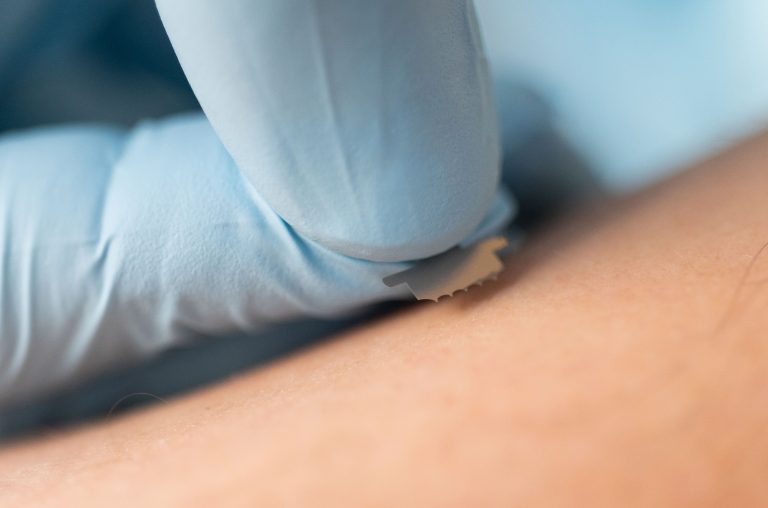
A patch of tiny microneedles developed at Georgia Institute of Technology can be used to extract interstitial fluid from beneath the skin for biomarker testing.
Interstitial fluid contains many valuable biomarkers, for example, it is used to measure glucose levels in the body by several commercially available continuous glucose monitors. However, the majority of medical tests resort to blood or urine sampling instead, mostly due to a lack of easy collection methods for interstitial fluid.
There are methods to collect this fluid, but without specialized tech they can be unpleasant or time consuming – such as applying heat and suction to the skin for an hour to create a blister and then piercing the blister to collect the fluid. Some methods also require minor surgery.
Mark Prausnitz, Ph.D., is a professor of chemical and biomolecular engineering at Georgia Tech and has previously developed microneedle patches to deliver drugs to the body with his research team. These patches are minimally invasive, as the needles are tiny and barely break the skin.
“We were able to leverage our experience with microneedle technology for drug delivery to create micropores in the skin and pull interstitial fluid out under suction,” he explained.
“One challenge was to avoid contaminating the fluid with blood, since microneedles can puncture capillaries. We addressed this by using very short microneedles and inserting them at an angle… We also slowly ramped up the suction pressure, which gave time for capillary resealing.”
As described in the journal Science Translational Medicine, Prausnitz and team – which also includes researchers at Emory University – compared blood and interstitial fluid taken from 21 volunteers to assess the type and level of biomarkers in both. They found more than 10,000 compounds in total, most of which could be detected in both blood and interstitial fluid.
“This means that many biomarkers of interest in the blood can be found in interstitial fluid too,” said Prausnitz. “An advantage of interstitial fluid compared to blood is that interstitial fluid does not clot, which makes continuous or repeated collections easier.”
For comparison purposes, the researchers also used the standard blister method to collect interstitial fluid and compared the results. While the type of liquid extracted was very similar, the blister method took longer and caused more skin damage and irritation. The researchers also found corticosterone, a marker of inflammation and injury, in the blister fluid but not that extracted using the microneedles. They believe this suggests that the collection method may introduce artifacts into the sample.
Although it contains similar compounds, interstitial fluid is not exactly the same as blood. The fluid has contact with multiple cells in the tissue, which change the levels of nutrients and metabolites that are present. Prausnitz believes it could be particularly useful for investigating skin conditions where skin biomarkers can be more easily found in dermal interstitial fluid than in blood.
Perfecting this collection method is not without difficulties. The team had some problems with evaporation of interstitial fluid while it was being extracted.
“While this did not affect our ability to determine the presence or relative concentration of a given biomarker, we needed to know the volume of interstitial fluid collection to determine absolute biomarker concentrations,” noted Prausnitz.
“We did this by measuring the amount of sodium in the dried interstitial fluid, because sodium level is maintained at a constant level in the body, absent a serious medical condition. In this way, knowing the amount of sodium allowed us to calculate the volume of interstitial fluid that had been collected.”
The researchers plan to further simplify the collection technique, as well as speeding up the collection time (at the moment it takes 20 minutes) and increasing the amount of interstitial fluid that can be collected.
“We want to make interstitial fluid easily available to the research community so that our colleagues interested in basic science and medical applications can assess this fluid in their research. We are also further studying potential uses of interstitial fluid in health care,” said Prausnitz.






![AI Algorithm Could Reduce Breast Cancer Mammogram False Positive Rate The primary goal of the Paradigm Registry is to accelerate tumor profiling based on disease biology. [iStock/LilliDay]](https://www.insideprecisionmedicine.com/wp-content/uploads/2019/01/307-218x150.jpeg)




